I
was amazed at the many gadgets and such that we used over there.
Infrared photos told us where all the trails and tunnels were. Side
scanning radar let us know what was moving when. And then there was
the "people sniffer". I didn't believe my ears at first, a chopper
that could smell out Charlie, you got to be kidding. It was real
though and sure was a different kind of mission.
Sure enough, here was a chopper fitted
out with two very large air scoops that were attached to the sides
and skids of the ship. The scoops led to a special console that
was positioned just behind the radio console. The console had
a visor over it so that an operator could stick his head in there and
read what was being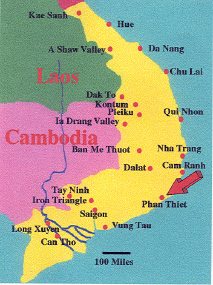
As was explained to me, the human body
gives off ammonia via the wrists and ankles. The more you sweat
the more ammonia is given off and the machine could read the ammonia
in parts per million. I was told that was the reason mosquitoes
seemed to bother some people more than others, it was the ammonia that
they were attracted to. Only trouble was that you had to fly slow
and low for supposedly accurate readings and that was a definite no-no
for pilots interested in longevity. The sniffer chopper was only
used when Charlie was suspected of gathering in any given area for whatever
reason. It's use usually required you to fly at tree top level
at a very low speed which invited pot shots so usually 2 gun ships flew
escort. Only trouble was that the guns couldn't really fly effectively
that slow and we were passed by many a time which looked nice but meant
we were not covered for seconds at a whack. The operator had to bury
his head in the console and would relay to us a "Mark" or "Hot" which we
promptly relayed to the C&C ship above, which was conveniently out
of bullet range. It was the C&C ship's job to mark on the map
where each reading was and whether it was just a "Mark" or a "Hot".
It was also C&C's job to tell us which direction to go in. Behind
the C&C was rescue 1 just in case we or a gun went down.
Though the mission was an interesting
one, pilot wise, we didn't like sticking out necks out like that. I did
know pilots though that volunteered for that mission and even flew it
without their chicken plate. While the pilots were enjoying the scenery
that was being forced on them the poor door gunner and crew chief were
at 100% with machine guns at the ready and eyeballs straining at the max
for that one guy that would jump out of the tree line and spray the ship
with AK-47 fire.
Now I have to admit the machinery was
impressive. The operator could not see where we were going or
what we were going over. On one occasion I turned the ship slightly
and flew directly over a lone Vietnamese boy that was on the back of a
water buffalo who was tending a herd of buffalo that were in an open field.
About 100 yds later the operator recorded a "Mark". It worked.
I flew the sniffer chopper several
times and on one occasion we inadvertently found out just how sensitive
that machine really was. I had been flying the sniffer ship,
with escort, somewhere south of the air base at Phan Rang and we had
come up empty. At the end of 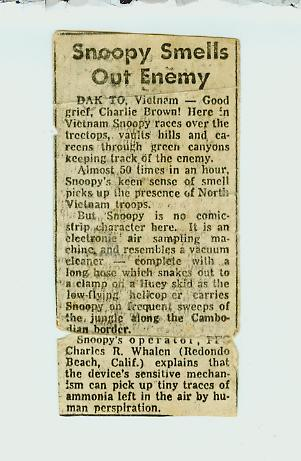 the day the other ships had to go do something else and I was told
to bring the ship back to Phan Thiet. South of Phan Rang was
a huge grass area that we sometimes when to hunt rabbits. It was
miles and miles of flat grass that was only about 6"-8" high with an occasional
gully here and there. There were rabbits there and when we had
to get rid of the old machine gun ammo we just used it up on the rabbits.
The gunners love it and it made things interesting for a while.
My best guess was 200 rounds per rabbit because they run back and forth
like an NFL halfback.
the day the other ships had to go do something else and I was told
to bring the ship back to Phan Thiet. South of Phan Rang was
a huge grass area that we sometimes when to hunt rabbits. It was
miles and miles of flat grass that was only about 6"-8" high with an occasional
gully here and there. There were rabbits there and when we had
to get rid of the old machine gun ammo we just used it up on the rabbits.
The gunners love it and it made things interesting for a while.
My best guess was 200 rounds per rabbit because they run back and forth
like an NFL halfback.
On this particular occasion we had
to get back fast so rabbit hunting was out. We did though get
down on the deck where we could low leveling at full speed and enjoy
one of the thrills of flight. All of a sudden the operator yells
out "Hot, Hot, Hot". He had apparently left the machine on and
it was giving a reading of "Hot" be it only for a few seconds.
We immediately pulled up and eyeballed the area. There was nothing
there, just grass and a small gully that maybe a little rabbit could hide
in.
With door gunners on the alert we got
down to sniffer speed and altitude and went over the spot from a different
angle. We got a "Hot" reading again just over the gully.
We did it again and got the same "Hot" reading. We didn't see anything
so we marked the spot on the map that the operator had and let it go at
that. When we got back the operator turned in the findings to headquarters.
A few days later we heard that the
local troops went for a look see and found 9 VC hold up in a tunnel
in the little gully that registered all the "Hot" readings. Seems
they were in there sweating away with the ammonia apparently going up
the vent holes. Glory be, the thing worked just as well at full
speed as at recommended speed.
It amazed me at all the little toys
and gadgets we had over there and that was just the ones that I was
privy to and remember I, as a warrant officer, was the lowest of the
lows officer wise. I sometimes wondered what was out there
that was being used that I would never know about. Somebody once
answered, when asked why the war was taking so long, "because there
were so many toys to play with". I sometimes wonder how many
lives were sacrificed for those toys and how many more were indeed saved
by those toys ? I know it had to be done but it still hurts thinking
of it that way.
The End.
30+ Years Later:
These stories have now
grown beyond just me and I don't mind that at all. I am no hero
by any means, I am but the messenger and these stories are here for
you to enjoy and to learn from so you may better understand what was
happening back then. With that in mind pertinent people of that
era sometime contact me with their similar stories. If what they
have to say fits into my stories and adds to them and I find them credible
I don't mind at all to include what they have to say with that specific
story.
One such person is Jack Inman, a "people
sniffer" operator who started "sniffing" up North in the Dak To area
just as I was going into the 192nd. Its people like Jack that did
their "thing" with little notice and in doing so saved many lives.
I'm surprised he is still here to talk about it all, he sure beat the
odds but then again, maybe it was meant to be that way all along.
Here is Jack's story.
More on "The People Sniffer"
Accounts by Jack Inman
(1968-1969)
My name is Jack Inman. I was referred to Galkie’s
web page about the “people sniffer” and Galkie asked me to contribute
a description of my experiences with similar technology.
I was a “people sniffer”, a.k.a. Airborne Personnel Detector.
My MOS (Military Operating Specialty?) in the US Army was 52E, Chemical
Staff Specialist. I was trained in Chemical, Biological and Radiological
(CBR) warfare at Ft. McClellan, AL in early 1968 and shipped out to
RVN in July, 1968 as a SP-4. I was assigned to the 4th Infantry
Division Chemical HQ. General duties included tear gas, defoliate
(e.g. Agent Orange), and flame weapon deployment, but soon after arrival
I was enticed into volunteering to become an APD 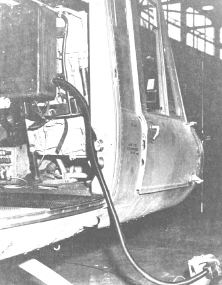 operator, which we called “Snoopy”. Snoopy was a volunteer
activity because of the inherent dangers involved, but I was intrigued
by the technology and it also got me out of the more mundane duties
that enlisted men were subject to such as KP and guard duty.
operator, which we called “Snoopy”. Snoopy was a volunteer
activity because of the inherent dangers involved, but I was intrigued
by the technology and it also got me out of the more mundane duties
that enlisted men were subject to such as KP and guard duty.
Yes, the people sniffer could “smell” people or human activity
in general such as body effluents, smoke or other exhausts, and it was
very effective. I'm not familiar with the exact equipment that
Galkie describes, but the technology certainly evolved with time and did
so even during my tour.
The first ADP equipment I worked with was actually designed
to be carried on a soldier's back in the jungle with a probe attached
to his rifle. I never operated it this way. This tactic
proved not to be very effective because air currents in the jungle are
irregular. It was in fact very possible to smell your own troops
using this tactic. It was also possible to walk right up to an
enemy without detecting him due to uncooperative air currents.
Plus the fact that it was an otherwise useless piece of equipment that
the soldier had to tote made it a passing fad on the ground.
However, the air circulated through the jungle, but also rose
to above the treetops, which offered a much better sample space.
The tactics evolved to mounting the APD in a helicopter and flying just
above the trees to collect and analyze the air samples. This proved
to be much more effective and also allowed a flight of helicopters to
follow up on the findings.
When I first started people sniffing I was transferred to Dak
To, in the Central Highlands, near the “Tri-border” of Viet Nam, Laos
and Cambodia, a very active enemy infiltration area. Its where
the infamous “Ho Chi Minh Trail” entered Viet Nam. Initially, the
APD equipment did not have a credible reputation and so I did not fly
very often, maybe a couple times a week. Usually, APD would be sent
in to add to other intelligence gathering information and in an attempt
to track possible enemy gathering places. I had more confidence in
my findings than command did and so did my commanding officer, Lt. Col.
Gillespie. He was a strong advocate of the Chemical Corps involvement
in the war including Airborne Personnel Detection.
The breakthrough in confidence about the equipment came after
one particular mission where we were asked to sniff out an abandoned
firebase that was scheduled to be reoccupied. The APD readings
of that base were very high and indicated substantial human activity 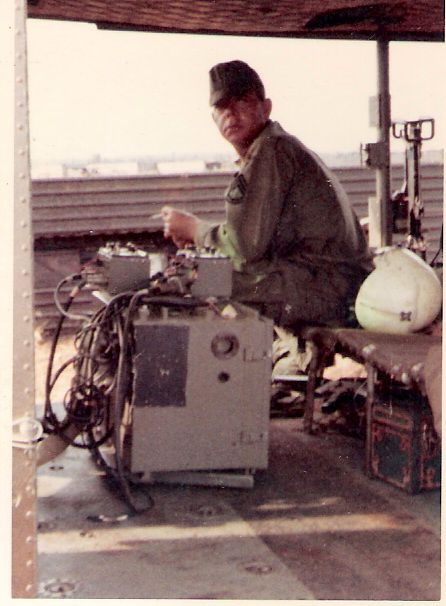 although any visuals or other intelligence gathering of activity
were unsupportive. The scuttlebutt was that snoopy was sniffing
buffalo dung or something. When the troops were eventually sent
in to re-occupy the base it was discovered to be heavily booby trapped.
Clearly snoopy had smelled something that no one else had. From
that point on, snoopy was in much more demand.
although any visuals or other intelligence gathering of activity
were unsupportive. The scuttlebutt was that snoopy was sniffing
buffalo dung or something. When the troops were eventually sent
in to re-occupy the base it was discovered to be heavily booby trapped.
Clearly snoopy had smelled something that no one else had. From
that point on, snoopy was in much more demand.
During this time, the ADP equipment was upgraded to a more accurate
model, one that took more samples faster. It was still necessary
to gather the samples at treetop level, and still necessary to fly “low
and slow” to gather them. We typically flew with three other ships,
two gun ships that trailed
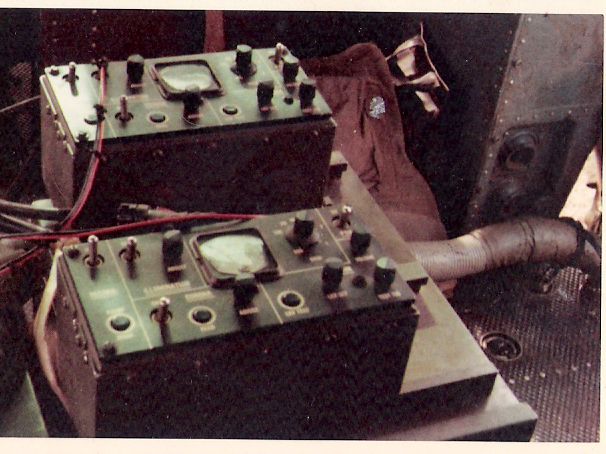 us and a chase ship flying high that directed
us and marked the readings on a map to detect patterns. I was
told that an enemy pamphlet was once found that described that flight
pattern and offered a bounty on the low flying ship, so apparently the
bad guys realized what we were doing, or that we were doing something
they'd prefer us not to be.
us and a chase ship flying high that directed
us and marked the readings on a map to detect patterns. I was
told that an enemy pamphlet was once found that described that flight
pattern and offered a bounty on the low flying ship, so apparently the
bad guys realized what we were doing, or that we were doing something
they'd prefer us not to be.
One discrepancy between our tactics and those described by Galkie
is that we had fairly rigorous rules about the patterns we flew.
Since the APD detected different kinds of activity, including engine
exhaust, we flew in a pattern upwind and perpendicular to the prevalent
air currents in order not to pick up our own exhaust. The gun
ships also had to be cognizant of this pattern and so were restricted
from flying into our up-pattern space. 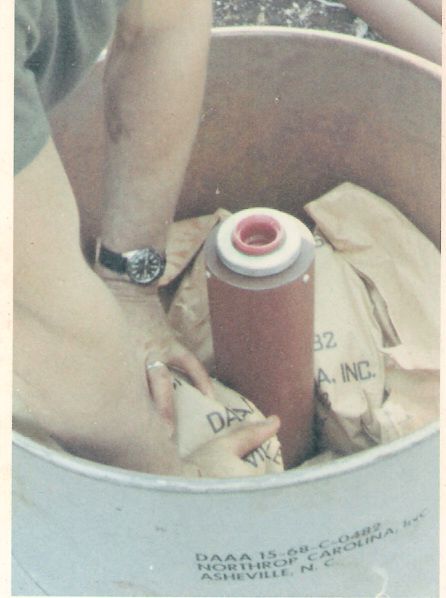
Note: I have inserted some of Jack's pictures
with the above two pictures showing the entire machine and then the two
meters, which gave the operator the readings he then had to interpolate.
I do not know why his equipment was different that the one we used.
The other pictures are of how they prepare a CS Gas drop, this one
out of the back of a Chinook Helicopter I believe. This made for a
predictable flight path that could be scary if you thought about it.
Picture a lone enemy gunman watching us go back and forth as if we were
spraying crops or something but in the distinctive group of low ship,
followed by a gun ship, followed by another gun ship and a chase ship
high above, all moving at a very tractable speed. He could just
wait for us to fly past, knowing where and when we would be passing, and
then just open fire. That happened several times and made areas with
low 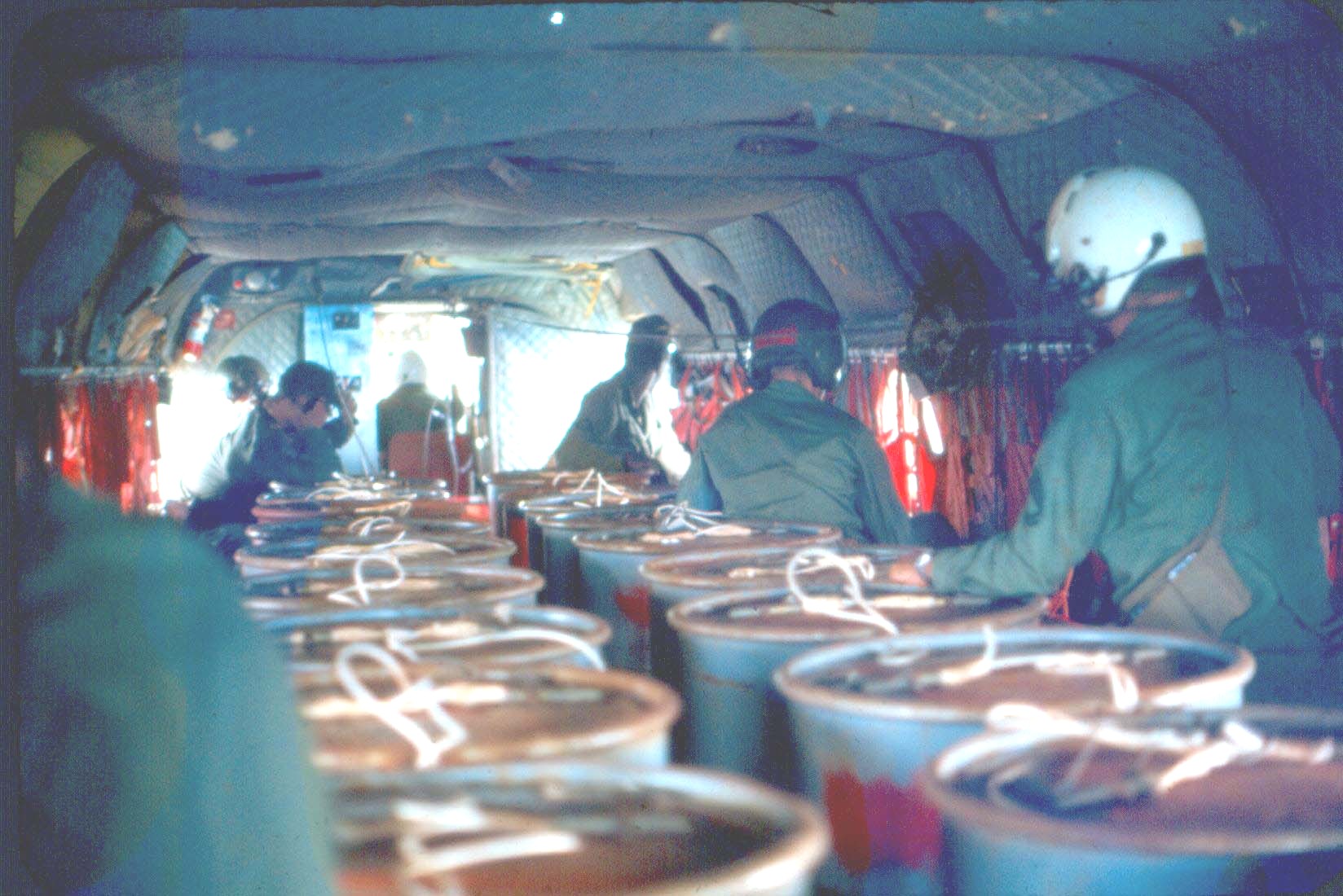 readings even scarier than those with heavy readings since large
contingents of enemy tended to avoid detection by holding their fire
and hiding.
readings even scarier than those with heavy readings since large
contingents of enemy tended to avoid detection by holding their fire
and hiding.
But it got even scarier as tactics
evolved. Initially, we were simply intelligence gatherers.
We'd collect the data and take it back to HQ for analysis and follow-up
planning. We did not usually initiate any action ourselves unless
we were fired upon and sometimes not even then since it was a known enemy
tactic to try to draw fire upon our own troop placements by shooting at
the gun ships when they happen to be flying near our own troops in order
to draw fire. Again, one or two enemy troops who happened to be near
our troops could cause a lot of trouble and potentially friendly fire upon
them. This was particularly tricky if Viet
Namese (ARVN) troops were in the area since they were not known for
their coordination. It required a lot of command coordination
for which we didn't always have the right information. You've heard
of “free fire zones”, well there were also “no fire zones”, even if
fired upon. These were very frustrating, particularly to the gunners
(although they did tend to like free fire zones). 
As evidence mounted that the APD was indeed detecting humans
on the ground pretty accurately, the tactics evolved to more search and
destroy rather than simply gather intelligence. I believe I could
smell as few as a couple or three humans if they had been around very long,
and certainly a large number of humans gathering (Ammonia is also found
in other body effluents such as urine), but also such sources as a launching
zone for mortars or rockets or smoke from campfires or marijuana “parties”.
I have no idea how many enemy troops I located during my tour, but I'm
sure it runs into the thousands.
And so a team was formed, the S.C.O.R.P.I.O.N team, which is
an acronym for Special Combined Operations for Personnel Identification
and Overt Neutralization. This team's mission was to basically
“sniff them out and snuff them out”. We shifted from flying mostly
in Huey’s (UH-1x), to Loaches (OH-6x) with a few field modifications on
them to mount the equipment efficiently and allow for low-level recon.
The chase ship was loaded with tear gas weaponry that could cover a couple
football fields in tear gas. We were accompanied by two Cobra (AH-1x)
gun ships and typically were assigned AO’s highly suspected of harboring
enemy troops. We would fly our snoopy pattern, then determine
the most likely areas where we could draw them out. The two Loaches
would then return to the treetops and hover, using the prop wash to blow
the foliage back. The objective was to make visual contact
or draw fire to positively identify a target location. This was
done  with the Cobras circling the area literally with our hover ships in their
sites. Although we were armed with our M-16s on the deck, our strategy
was to immediately vacate the area when fired upon and leave the heavy
work to the gun ships. If things got real interesting, we would call
in artillery or air strikes. A few times this was followed up by
even more intense ground operations.
with the Cobras circling the area literally with our hover ships in their
sites. Although we were armed with our M-16s on the deck, our strategy
was to immediately vacate the area when fired upon and leave the heavy
work to the gun ships. If things got real interesting, we would call
in artillery or air strikes. A few times this was followed up by
even more intense ground operations.
I flew over 500 missions in Viet Nam, some of which were
tear gas drops or defoliation, but mostly they were snoopy missions.
I was shot down with my trainer, Chuck Whalen, in September and he stopped
flying after that. In October another snoopy, a close friend in
fact, Warren Haugen, was shot down and killed, which persuaded the only
other snoopy operator in the Highlands (II Corps), Pete
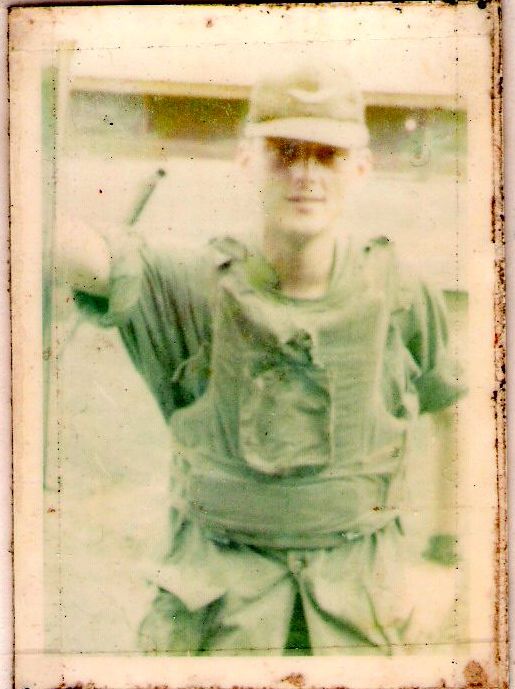 James, to quit flying. A gun ship on the SCORPION
team was shot down in about February killing both occupants, which dissuaded
others from volunteering until a new batch of “volunteers” were recruited in March
or April. What this meant to me is that between about December
’68 till April ’69 I was the only snoopy operator in the area and so I flew
just about every day with a SCORPION team, often several missions in a
day depending on activity. Not all missions were hot, but we
James, to quit flying. A gun ship on the SCORPION
team was shot down in about February killing both occupants, which dissuaded
others from volunteering until a new batch of “volunteers” were recruited in March
or April. What this meant to me is that between about December
’68 till April ’69 I was the only snoopy operator in the area and so I flew
just about every day with a SCORPION team, often several missions in a
day depending on activity. Not all missions were hot, but we 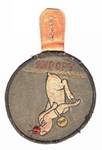 had our share. I estimate somewhere
between 30 and 40 missions came under direct fire. That's actually
less than 10% if you think about it, so mostly, it was just another day
in paradise flying on the deck over the jungle looking for trouble.
Note: Jack sent me this picture of him taken just after he received
a round to the chest. You can see the bullet hole between his lower
neck and the top portion of that little square pouch area of his chicken
plate. I was just a tekkie passenger, but I flew some exciting missions
with a lot of very skilled and very brave airmen. I flew with different
pilots and crew, and with different units in different places.
I hardly remember their names, but with few exceptions, all of those
guys were extremely professional and heroic. I sincerely believe
we accomplished our missions and eradicated many enemy troops who were
out to do our buddies and allies harm otherwise. People called
me crazy for doing what I did over there, but for me, it was my unique
niche and I really thought I was doing some good. I'm just now
coming to grips with it myself. Thanks Galkie!
had our share. I estimate somewhere
between 30 and 40 missions came under direct fire. That's actually
less than 10% if you think about it, so mostly, it was just another day
in paradise flying on the deck over the jungle looking for trouble.
Note: Jack sent me this picture of him taken just after he received
a round to the chest. You can see the bullet hole between his lower
neck and the top portion of that little square pouch area of his chicken
plate. I was just a tekkie passenger, but I flew some exciting missions
with a lot of very skilled and very brave airmen. I flew with different
pilots and crew, and with different units in different places.
I hardly remember their names, but with few exceptions, all of those
guys were extremely professional and heroic. I sincerely believe
we accomplished our missions and eradicated many enemy troops who were
out to do our buddies and allies harm otherwise. People called
me crazy for doing what I did over there, but for me, it was my unique
niche and I really thought I was doing some good. I'm just now
coming to grips with it myself. Thanks Galkie!
Jack Inman (jaxinman@yahoo.com)
SP-4, 4th ID Chem
Camp Enari, Pleiku, RVN
July ’68-July ‘69

 the day the other ships had to go do something else and I was told
to bring the ship back to Phan Thiet. South of Phan Rang was
a huge grass area that we sometimes when to hunt rabbits. It was
miles and miles of flat grass that was only about 6"-8" high with an occasional
gully here and there. There were rabbits there and when we had
to get rid of the old machine gun ammo we just used it up on the rabbits.
The gunners love it and it made things interesting for a while.
My best guess was 200 rounds per rabbit because they run back and forth
like an NFL halfback.
the day the other ships had to go do something else and I was told
to bring the ship back to Phan Thiet. South of Phan Rang was
a huge grass area that we sometimes when to hunt rabbits. It was
miles and miles of flat grass that was only about 6"-8" high with an occasional
gully here and there. There were rabbits there and when we had
to get rid of the old machine gun ammo we just used it up on the rabbits.
The gunners love it and it made things interesting for a while.
My best guess was 200 rounds per rabbit because they run back and forth
like an NFL halfback.  operator, which we called “Snoopy”. Snoopy was a volunteer
activity because of the inherent dangers involved, but I was intrigued
by the technology and it also got me out of the more mundane duties
that enlisted men were subject to such as KP and guard duty.
operator, which we called “Snoopy”. Snoopy was a volunteer
activity because of the inherent dangers involved, but I was intrigued
by the technology and it also got me out of the more mundane duties
that enlisted men were subject to such as KP and guard duty.  although any visuals or other intelligence gathering of activity
were unsupportive. The scuttlebutt was that snoopy was sniffing
buffalo dung or something. When the troops were eventually sent
in to re-occupy the base it was discovered to be heavily booby trapped.
Clearly snoopy had smelled something that no one else had. From
that point on, snoopy was in much more demand.
although any visuals or other intelligence gathering of activity
were unsupportive. The scuttlebutt was that snoopy was sniffing
buffalo dung or something. When the troops were eventually sent
in to re-occupy the base it was discovered to be heavily booby trapped.
Clearly snoopy had smelled something that no one else had. From
that point on, snoopy was in much more demand.  us and a chase ship flying high that directed
us and marked the readings on a map to detect patterns. I was
told that an enemy pamphlet was once found that described that flight
pattern and offered a bounty on the low flying ship, so apparently the
bad guys realized what we were doing, or that we were doing something
they'd prefer us not to be.
us and a chase ship flying high that directed
us and marked the readings on a map to detect patterns. I was
told that an enemy pamphlet was once found that described that flight
pattern and offered a bounty on the low flying ship, so apparently the
bad guys realized what we were doing, or that we were doing something
they'd prefer us not to be. 
 readings even scarier than those with heavy readings since large
contingents of enemy tended to avoid detection by holding their fire
and hiding.
readings even scarier than those with heavy readings since large
contingents of enemy tended to avoid detection by holding their fire
and hiding. 
 with the Cobras circling the area literally with our hover ships in their
sites. Although we were armed with our M-16s on the deck, our strategy
was to immediately vacate the area when fired upon and leave the heavy
work to the gun ships. If things got real interesting, we would call
in artillery or air strikes. A few times this was followed up by
even more intense ground operations.
with the Cobras circling the area literally with our hover ships in their
sites. Although we were armed with our M-16s on the deck, our strategy
was to immediately vacate the area when fired upon and leave the heavy
work to the gun ships. If things got real interesting, we would call
in artillery or air strikes. A few times this was followed up by
even more intense ground operations.  James, to quit flying. A gun ship on the SCORPION
team was shot down in about February killing both occupants, which dissuaded
others from volunteering until a new batch of “volunteers” were recruited in March
or April. What this meant to me is that between about December
’68 till April ’69 I was the only snoopy operator in the area and so I flew
just about every day with a SCORPION team, often several missions in a
day depending on activity. Not all missions were hot, but we
James, to quit flying. A gun ship on the SCORPION
team was shot down in about February killing both occupants, which dissuaded
others from volunteering until a new batch of “volunteers” were recruited in March
or April. What this meant to me is that between about December
’68 till April ’69 I was the only snoopy operator in the area and so I flew
just about every day with a SCORPION team, often several missions in a
day depending on activity. Not all missions were hot, but we  had our share. I estimate somewhere
between 30 and 40 missions came under direct fire. That's actually
less than 10% if you think about it, so mostly, it was just another day
in paradise flying on the deck over the jungle looking for trouble.
Note: Jack sent me this picture of him taken just after he received
a round to the chest. You can see the bullet hole between his lower
neck and the top portion of that little square pouch area of his chicken
plate. I was just a tekkie passenger, but I flew some exciting missions
with a lot of very skilled and very brave airmen. I flew with different
pilots and crew, and with different units in different places.
I hardly remember their names, but with few exceptions, all of those
guys were extremely professional and heroic. I sincerely believe
we accomplished our missions and eradicated many enemy troops who were
out to do our buddies and allies harm otherwise. People called
me crazy for doing what I did over there, but for me, it was my unique
niche and I really thought I was doing some good. I'm just now
coming to grips with it myself. Thanks Galkie!
had our share. I estimate somewhere
between 30 and 40 missions came under direct fire. That's actually
less than 10% if you think about it, so mostly, it was just another day
in paradise flying on the deck over the jungle looking for trouble.
Note: Jack sent me this picture of him taken just after he received
a round to the chest. You can see the bullet hole between his lower
neck and the top portion of that little square pouch area of his chicken
plate. I was just a tekkie passenger, but I flew some exciting missions
with a lot of very skilled and very brave airmen. I flew with different
pilots and crew, and with different units in different places.
I hardly remember their names, but with few exceptions, all of those
guys were extremely professional and heroic. I sincerely believe
we accomplished our missions and eradicated many enemy troops who were
out to do our buddies and allies harm otherwise. People called
me crazy for doing what I did over there, but for me, it was my unique
niche and I really thought I was doing some good. I'm just now
coming to grips with it myself. Thanks Galkie!